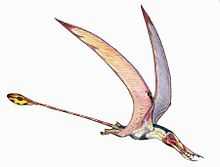Paleontology, palaeontology or palæontology (from Greek: paleo, "ancient"; ontos, "being"; and logos, "knowledge") is the study of prehistoric life forms on Earth through the examination of plant and animal fossils.[1] This includes the study of body fossils, tracks (ichnites), burrows, cast-off parts, fossilised feces (coprolites), palynomorphs and chemical residues. Because mankind has encountered fossils for millennia, paleontology has a long history both before and after becoming formalized as a science. This article records significant discoveries and events related to paleontology that occurred in the year 1846.
Dinosaurs
Newly named dinosaurs
|
|
|
|---|
| Name |
Status |
Authors |
Notes |
|
Smilodon[2] |
Misidentification. |
Plieninger |
|
A misidentified phytosaur. The name was also preoccupied by the well known species of prehistoric cat. The genus was later renamed Zanclodon. |
|
Zanclodon |
Misidentification. |
Plieninger |
|
A misidentified phytosaur formerly known as Smilodon. |
|
|
|
|
|
Pterosaurs
New taxa
Synapsids
Non-mammalian
| Name |
Status |
Authors |
Discovery year |
Age |
Unit |
Location |
Notes |
Images |
|
Scymnorhinus |
Valid |
Bonaparte |
|
|
|
|
|
|
|
References
- ↑ Gini-Newman, Garfield; Graham, Elizabeth (2001). Echoes from the past: world history to the 16th century. Toronto: McGraw-Hill Ryerson Ltd. ISBN 9780070887398. OCLC 46769716.
- ↑ Plieninger, T. 1846. Ueber ein neues
Sauriergenus. Jahreschefte Verein fur
Vaterlandische Naturkunde in Wurttemberg 2.

